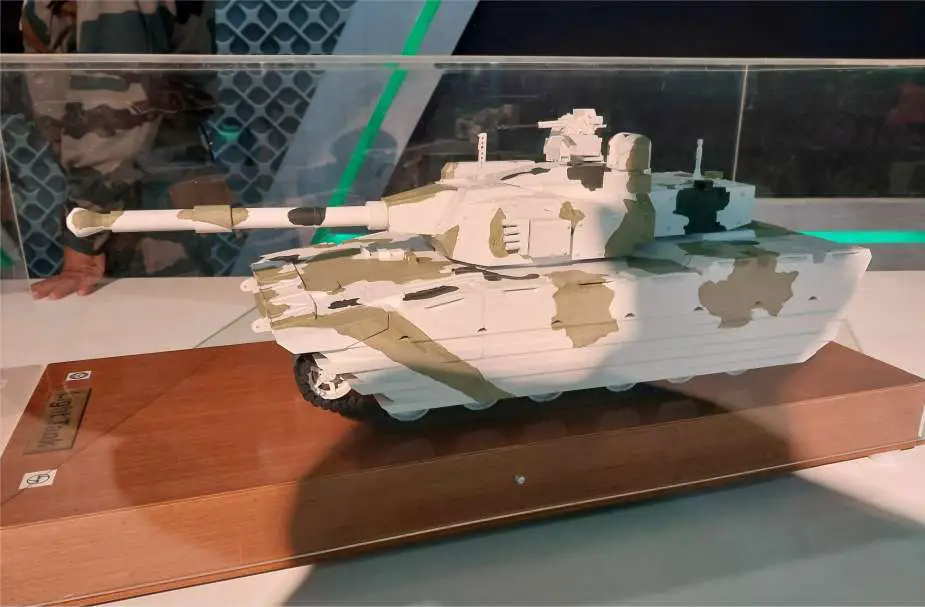Breaking news
India prepares Zorawar light tank to confront China in Himalayan region.
According to ANI on January 12, 2024, India's domestically developed light tank project, known as Zorawar, is progressing as the first prototype gets ready for upcoming trials later this month. This tank, designed for deployment in the Himalayan border regions along the disputed border with China, has been a collaborative effort between the Defence Research and Development Organisation (DRDO) and private vendor Larsen & Toubro (L&T).
Follow Army Recognition on Google News at this link

Scale model of the Zorawar light tank at DefExpo 2022 exhibition in India (Picture source: Twitter/JenilP1819)
Preliminary movement testing, covering a distance of over 100 kilometers, has taken place at the development and production partner's facilities. Initially, the introduction of the Zorawar into the Army's arsenal was scheduled for December, with trials intended for desert and high-altitude locations. However, due to delays in engine supplies from Germany, the project's timeline was extended.
The Indian Army plans to induct seven light tank regiments, totaling around 315 tanks, with an additional 40 in reserve. The Ministry of Defence (MoD) granted its Acceptance of Necessity (AoN) for this project in December 2021. The AoN was the first step in the procurement process under the MoD's Defence Acquisition Procedure-2020 (DAP-2020).
The DRDO then selected the Indian company Larsen & Toubro (L&T) as its developmental partner for the light tank program, with L&T set to series-build 59 of these light tanks after successful trials. The remaining 290 vehicles will be tendered out to other local manufacturers under the 'Make in India' category, ensuring fairness in the procurement process.
However, it will also mean that the Indian Army will simultaneously field five different tank types, including the existing T-72M1 Ajeya, T-90S Bhishma, and indigenous Arjun Mk1 Main Battle Tanks (MBTs), along with the planned medium-weight Future Ready Combat Vehicles (FRCV). This diversity of platforms, with the acquisition of sector-specific platforms like the Zorawar light tank, will certainly present additional logistical challenges and financial burdens for the Indian Army.
The Zorawar light tank project, approved by the Defence Acquisition Council, is part of India's strategy to address the capabilities of neighboring forces, especially China. Named after a 19th-century general who played a role in the history of Ladakh and Baltistan, the Zorawar light tank weighs approximately 25 tonnes and is designed to be air-transportable and amphibious, making it suitable for challenging terrains in the Himalayas. This development aims to address the strategic requirements in the Ladakh sector, particularly in comparison to China's ZTQ-15 light tanks.
The Zorawar development followed tensions in the Ladakh region since 2020 when hundreds of Chinese soldiers, supported by tanks and artillery, intruded into Indian territory in Ladakh. They remain there despite multiple rounds of talks between senior military commanders from both sides.
In response to these intrusions, the Indian Army has airlifted nearly 200 tanks to Ladakh. However, the Indian Army's existing armored units, equipped with T-72 Main Battle Tanks, faced mobility challenges in the high-altitude terrain, unlike the Chinese ZTQ-15 light tanks. Primarily because China's ZTQ-15's 1,000 hp engines generate power-to-weight ratios of over 30 HP per tonne, adequate for the oxygen-depleted altitude. In contrast, India’s 42 tonnes T-72s, with their underpowered 780 hp engines, offer a power-to-weight ratio of just 18.5 HP per tonne, hampering their mobility in the challenging terrain.
One significant hurdle during the development of the Zorawar was the negotiation with Germany for the supply of the MTU 800-1,000hp water-cooled V8 high-altitude-optimized engines. Despite diplomatic efforts, these negotiations were recently scrapped, leading to the acquisition of an alternate 1,000hp engine from the US company Cummins, which will be manufactured in India, to meet the “Make in India” norm.
There were two options, however, for the light tank’s turret. In one, the K9 Vajra’s 155 mm artillery gun turret would be replaced by a T-90 tank turret with a heavy 125 mm tank gun. However, the 8-9-tonne T-90 tank turret, mounted on the 28-tonne chassis, took the weight of the light tank to an unacceptable 36-37 tonnes.
The second option, which was finally selected, involved replacing the K-9 Vajra’s turret with a smaller one, fitted with a ready-built 105mm gun acquired from the Belgian firm John Cockerill, violating the defense ministry’s “Make in India” norms. But DRDO officials say that, once it was decided to indigenize the turret, their experience in designing the Arjun tank turret proved invaluable. Furthermore, designing the 105 mm tank gun proved well within the capabilities of the Kalyani Group.
According to Indian sources, the Zorawar light tank features an active protection system, artificial intelligence technologies, and the integration of tactical drones to enhance situational awareness and provide loitering munition capability. If the weight of the Zorawar is kept below 25 tonnes, the power-to-weight ratio will be 30 HP per tonne – meeting the Indian Army’s norms. Therefore, it is believed that these tanks will match or even exceed the mobility, firepower, and accuracy of the PLA's ZTQ-15 light tanks, which are currently deployed along the Line of Actual Control (LAC), especially aiming at the Ladakh sector.























